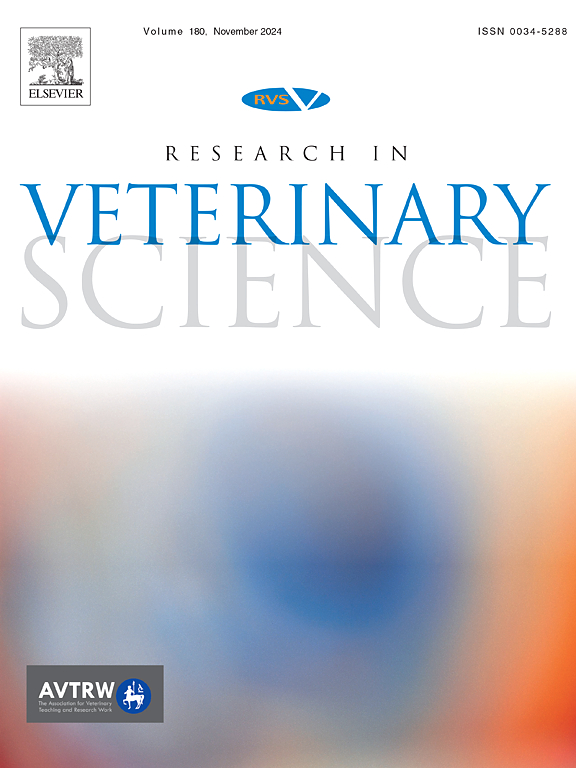甲硝唑在绵羊和山羊体内的药代动力学比较评价
IF 2.2
3区 农林科学
Q1 VETERINARY SCIENCES
引用次数: 0
摘要
甲硝唑(meonidazole, MTZ)是一种5-硝基咪唑类化合物,具有抗菌和抗原虫双重特性。由于缺乏文献数据,该药物在许多国家未被批准用于农场用药,该研究旨在确定静脉(IV)和皮下(SC)给药后其在绵羊和山羊体内的药代动力学(PK)。绵羊(n = 5)和山羊(n = 5)遵循相同的研究方案,包括两阶段,单剂量(2 mg/kg),交叉研究设计,两次治疗之间有一周的洗脱期。24小时内采集血样进行分析。采用高效液相色谱法进行血浆药物定量。该方法具有良好的线性、回收率和精密度。MTZ在两种动物中都表现出相对较快的消除速度,其中山羊的消除速度更快。山羊的清除率明显较高,因此AUC值较低。这强调了在为小反刍动物开处方时考虑药物代谢和清除的物种特异性差异的重要性。认识到AUC/MIC在预测MTZ疗效中的关键作用,这两种动物之间的剂量调整可能是必要的,以确保最佳的治疗效果。这两种动物的生物利用度都相对较高,这表明SC给药在小型反刍动物中有作为一种实用方法的潜力,类似于最近人类医学对MTZ给药的趋势。需要进一步的研究来彻底评估MTZ在患病绵羊和山羊体内的有效性,包括多次给药后的PK研究,以便为这些动物建立合适的给药方案。本文章由计算机程序翻译,如有差异,请以英文原文为准。
Comparative pharmacokinetic evaluation of metronidazole in sheep and goats
Metronidazole (MTZ) is a 5-nitroimidazole compound recognized for its dual anti-bacterial and anti-protozoal properties. Non-approved in many countries for farm medicine, due to a lack of data in the literature, the study aimed to determine its pharmacokinetics (PK) in sheep and goats following intravenous (IV) and subcutaneous (SC) administrations. Sheep (n = 5) and goats (n = 5) followed identical study protocols, which involved a two-phase, single-dose (2 mg/kg), cross-over study design with a one-week washout period between treatments. Blood samples were collected over 24 h for analysis. High-performance liquid chromatography (HPLC) was employed for plasma drug quantification. The analytical method exhibited excellent linearity, recovery, and precision. MTZ exhibited relatively rapid elimination in both animal species, notably faster in goats. Goats have shown a significantly higher clearance rate and consequently lower AUC values. This underscores the importance of considering species-specific differences in drug metabolism and clearance when prescribing medications for small ruminants. Recognizing the pivotal role of AUC/MIC in predicting MTZ efficacy, a dosage adjustment between these two animal species may be necessary to ensure optimal therapeutic outcomes. The bioavailability was relatively high in both animal species, suggesting the potential of SC administration as a practical approach in small ruminants, akin to recent trends in human medicine regarding MTZ administration. Additional research is needed to thoroughly assess the in vivo effectiveness of MTZ in diseased sheep and goats, including PK studies after multiple doses, to establish an appropriate dosing regimen for these animals.
求助全文
通过发布文献求助,成功后即可免费获取论文全文。
去求助
来源期刊

Research in veterinary science
农林科学-兽医学
CiteScore
4.40
自引率
4.20%
发文量
312
审稿时长
75 days
期刊介绍:
Research in Veterinary Science is an International multi-disciplinary journal publishing original articles, reviews and short communications of a high scientific and ethical standard in all aspects of veterinary and biomedical research.
The primary aim of the journal is to inform veterinary and biomedical scientists of significant advances in veterinary and related research through prompt publication and dissemination. Secondly, the journal aims to provide a general multi-disciplinary forum for discussion and debate of news and issues concerning veterinary science. Thirdly, to promote the dissemination of knowledge to a broader range of professions, globally.
High quality papers on all species of animals are considered, particularly those considered to be of high scientific importance and originality, and with interdisciplinary interest. The journal encourages papers providing results that have clear implications for understanding disease pathogenesis and for the development of control measures or treatments, as well as those dealing with a comparative biomedical approach, which represents a substantial improvement to animal and human health.
Studies without a robust scientific hypothesis or that are preliminary, or of weak originality, as well as negative results, are not appropriate for the journal. Furthermore, observational approaches, case studies or field reports lacking an advancement in general knowledge do not fall within the scope of the journal.
 求助内容:
求助内容: 应助结果提醒方式:
应助结果提醒方式:


